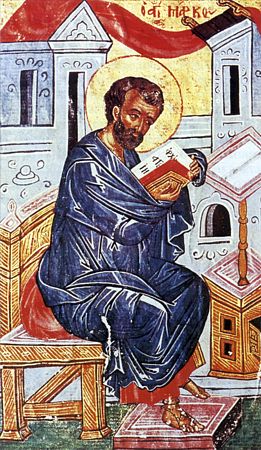
The Holy Disciple and Evangelist Mark
Commemorated on April 25
The Holy Disciple
and Evangelist Mark, named also John-Mark (Acts 12: 12), was a Disciple
from among the Seventy, and was also a nephew of the Disciple Barnabas (Comm.
11 June). He was born at Jerusalem. The house of his mother Mary adjoined the
Garden of Gethsemane. As Church Tradition relates, on the night of the
Sufferings of Christ on the Cross he followed after Him, wrapped in a linen
winding-cloth, and he fled from the soldiers catching hold of him (Mk. 14:
51-52). After the Ascension of the Lord, the house of his mother Saint Mary
became a place of prayerful gatherings of Christians and a lodging for certain
of the Apostles (Acts 12: 12).
Saint Mark was a very
close companion of the Apostles Peter and Paul (Comm. 29 June) and of the
Disciple Barnabas. Saint Mark was at Seleucia together with Paul and Barnabas,
and from there he set off to the island of Cyprus, and he crossed over the
whole of it from East to West. In the city of Paphos Saint Mark was an
eye-witness, of how the Apostle Paul had struck blind the sorcerer Elymas (Acts
13: 6-12).

After working with
the Apostle Paul, Saint Mark returned to Jerusalem, and then with the Apostle
Peter he arrived in Rome, from whence at the latter's bidding he set out for
Egypt, where he became founder of the Church.
During the time of
the second evangelic journey of the Apostle Paul, Saint Mark met up with him at
Antioch. From there he set out preaching with the Disciple Barnabas to Cyprus,
and then he went off again to Egypt, where together with the Apostle Peter he
founded many churches, and then also at Babylon. From this city the Apostle
Peter directed an Epistle to the Christians of Asia Minor, in which he points
to Saint Mark as his spiritual son (1 Pet. 5: 13).
When the Apostle Paul
came in chains to Rome, the Disciple Mark was at Ephesus, where the
cathedra-seat was occupied by Saint Timothy (Comm. 4 January). The Disciple
Mark arrived together with him in Rome. There also he wrote his holy Gospel
(c. 62-63).
From Rome Saint Mark
again set off to Egypt. At Alexandria he made the beginnings of a Christian
school, from which later on emerged such famous fathers and teachers of the
Church, as Clement of Alexandria, Sainted Dionysios (5 October), Sainted
Gregory Thaumatourgos ("Wonderworker", Comm. 5 November), and others.
Zealous with the arranging of Church Divine-services, the holy Disciple Mark
compiled the order of Liturgy for the Alexandrian Christians.
Later on in preaching
the Gospel, Saint Mark also visited the inner regions of Africa, and he was in
Libya at Nektopolis.
During the time of
these journeys, Saint Mark received inspiration of the Holy Spirit to go again
to Alexandria and confront the pagans. There he visited at the home of the
dignitary Ananias, for whom he healed a crippled hand. The dignitary happily
took him in, hearkened with faith to his narratives, and received Baptism. And
following the example of Ananias, many of the inhabitants of that part of the
city where he lived were baptised after him. This roused the enmity of the pagans,
and they gathered to kill Saint Mark. Having learned of this, the holy Disciple
Mark made Ananias bishop, and the three Christians: Malchos, Sabinos and
Kerdinos – presbyters.
The pagans pounced
upon Saint Mark when he was making Divine-services. They beat him, dragged him
through the streets and threw him in prison. There Saint Mark was granted a
vision of the Lord Jesus Christ, Who strengthened him before his sufferings. On
the following day the angry crowd again dragged the holy disciple through the
streets towards the court-room, but along the way Saint Mark died with the
words: "Into Thy hands, O Lord, I commend my spirit".
The pagans wanted to
burn the body of the holy disciple. But when they lit up the bon-fire,
everything grew dim, thunder crashed and an earthquake occurred. The pagans
fled in terror, and Christians took up the body of the holy disciple and buried
it in a stone crypt. This was on 4 April in the year 63. The Church celebrates
his memory on 25 April.
In the year 310, a
church was built over the relics of the holy Disciple Mark. In the year 820,
when the Mahometan Arabs had established their rule in Egypt and those of this
different faith oppressed the Christian Church, the relics of Saint Mark were
transferred to Venice and placed in the church of his name.
In the ancient
iconographic tradition, which adopted symbols for the holy Evangelists borrowed
from the vision of Saint John the Theologian (Rev. 4: 7), the holy Evangelist
Mark is depicted by a lion – symbolising the might and royal dignity of Christ
(Rev. 5: 5). Saint Mark wrote his Gospel for Christians from among the
gentile-pagans, since he emphasises predominantly the words and deeds of the
Saviour, in which particularly is manifest His Divine Almightiness. The many particularities
of his account can be explained by his proximity to the holy Apostle Peter. All
the ancient writers testify, that the Gospel of Mark represents a concise
writing-down of the preaching and narratives of the first-ranked Apostle Peter.
One of the central theological themes in the Gospel of Saint Mark is the theme
of the power of God, doing the humanly impossible, wherein the Lord makes
possible that which of man is impossible. By the efficacy of Christ
(Mk. 16: 20) and the Holy Spirit (Mk. 13: 11), His disciples are to
go forth into the world and preach the Gospel to all creatures (Mk. 13: 10, 16:
15).
© 1996-2001 by translator Fr. S. Janos.